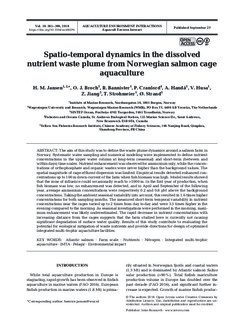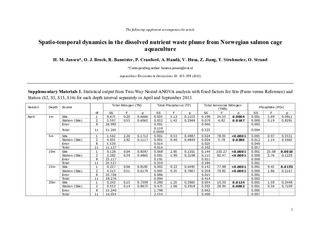| dc.contributor.author | Jansen, Henrice M | |
| dc.contributor.author | Broch, Ole Jacob | |
| dc.contributor.author | Bannister, Raymond | |
| dc.contributor.author | Cranford, Peter J. | |
| dc.contributor.author | Handå, Aleksander | |
| dc.contributor.author | Husa, Vivian | |
| dc.contributor.author | Jiang, Zengjie | |
| dc.contributor.author | Strohmeier, Tore | |
| dc.contributor.author | Strand, Øivind | |
| dc.date.accessioned | 2018-10-25T10:58:12Z | |
| dc.date.available | 2018-10-25T10:58:12Z | |
| dc.date.created | 2018-10-15T09:00:24Z | |
| dc.date.issued | 2018 | |
| dc.identifier.citation | Aquaculture Environment Interactions. 2018, 10 385-399. | |
| dc.identifier.issn | 1869-215X | |
| dc.identifier.uri | http://hdl.handle.net/11250/2569549 | |
| dc.description.abstract | The aim of this study was to define the waste plume dynamics around a salmon farm in Norway. Systematic water sampling and numerical modeling were implemented to define nutrient concentrations in the upper water column at long-term (seasonal) and short-term (between and within days) time scales. Nutrient enhancement was observed for ammonium only, while the concentrations of orthophosphate and organic wastes were never higher than the background values. The spatial magnitude of cage effluent dispersion was limited. Empirical results detected enhanced concentrations up to 100 m down-current of the farm when fish biomass was high. Model results showed that the zone of influence could occasionally reach to >1000 m. In the first year of production, when fish biomass was low, no enhancement was detected, and in April and September of the following year, average ammonium concentrations were respectively 0.2 and 0.8 μM above the background concentrations. Taking the ambient seasonal variability into account, this resulted in 1.6 times higher concentrations for both sampling months. The measured short-term temporal variability in nutrient concentrations near the cages varied up to 2 times from day to day and were 3.5 times higher in the evening compared to the morning. As seasonal investigations were performed in the morning, maximum enhancement was likely underestimated. The rapid decrease in nutrient concentrations with increasing distance from the cages suggests that the farm studied here is currently not causing significant degradation of surface water quality. Results of this study contribute to evaluating the potential for ecological mitigation of waste nutrients and provide directions for design of optimized integrated multi-trophic aquaculture facilities. | |
| dc.language.iso | eng | |
| dc.title | Spatio-temporal dynamics in the dissolved nutrient waste plume from Norwegian salmon cage aquaculture | |
| dc.title.alternative | Spatio-temporal dynamics in the dissolved nutrient waste plume from Norwegian salmon cage aquaculture | |
| dc.type | Peer reviewed | |
| dc.type | Journal article | |
| dc.description.version | publishedVersion | |
| dc.source.pagenumber | 385-399 | |
| dc.source.volume | 10 | |
| dc.source.journal | Aquaculture Environment Interactions | |
| dc.identifier.doi | 10.3354/aei00276 | |
| dc.identifier.cristin | 1620286 | |
| dc.relation.project | Notur/NorStore: NN2967k | |
| cristin.unitcode | 7431,0,0,0 | |
| cristin.unitcode | 7431,12,0,0 | |
| cristin.unitname | Havforskningsinstituttet | |
| cristin.unitname | Bentiske ressurser og prosesser | |
| cristin.ispublished | true | |
| cristin.fulltext | original | |
| cristin.qualitycode | 1 | |

